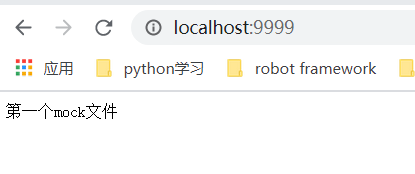使用Moco框架的mock技术
一、moco概述
Moco可以通过简单的配置request和response 对象,达到模拟后端返回的效果;
- 支持HTTP、HTTPS、socket协议;
- 支持在request中设置Headers、cookies、statusCode;
- 支持get、post、put、delete请求;
- 无需环境配置,只需要java运行环境即可
二、环境准备
moco安装使用只需要下载moco jar包即可
三、moco的使用
1)新建json配置文件(test.json),用于配置请求和响应内容,可根据需求自定义配置,内容如下:
[
{
"request":{
"uri":"/"
},
"response":{
"text":"第一个mock文件"
}
}
]
2)启动moco服务
在moco服务器cmd窗口,进入moco jar包所在目录,执行命令:
java –jar moco-runner-1.1.0-standalone.jar http –p 9999 –c test.json
http:指定http协议
-p:指定启动服务的端口号
-c:指定启动服务使用的json文件
成功启动界面如下:

3)接口请求调用
通过浏览器或者通过接口调用工具(postman、jmeter等)输入接口请求地址,http://localhost:9999/
调用结果如下:

四、更多的JSON文件配置
1、get请求
[
{
"description":"不带参数的get请求",
"request":{
"uri":"/withGetDemo",
"method":"get"
},
"response":{
"text":"这是不带参数的get请求"
}
},
{
"description":"带参数的get请求,p1,p2分别的参数1,参数2,名称可随便起,个数也可随便加",
"request":{
"uri":"/wihtGetDemobyParam",
"method":"get",
"queries":{
"p1":"hh",
"p2":"good"
}
},
"response":{
"text":"this is a get method with paramter"
}
}
]
2、post请求
[ { "description":"post 请求", "request":{ "uri":"/postDemo", "method":"post" }, "response":{ "text":"This is post request" } }, { "description":"带参数的post请求", "request":{ "uri":"/postDemoWithParam", "method":"post", "forms":{ "param1":"one", "param2":"two" } }, "response":{ "text":"this is post request with param" } } ]
3、post请求,(请求参数为json格式、请求带cookies)
[ { "description":"这是一个带cookies的Post请求", "request":{ "uri":"/postDemoWithCookies", "cookies":{ "login":"true" }, "json":{ "name":"hi", "age":"3" } }, "response":{ "status":"200", "json":{ "name":"success", "status":"1" } } } ]
4、请求带header
[ { "description":"带header请求", "request": { "uri": "/withHeader", "method": "post", "headers": { "content-type": "application/json" }, "json": { "name": "xiaoming", "age": "18" } }, "response":{ "json":{ "message":"success", "status":"1" } } } ]
五、总结
Moco还可以通过在json文件中添加cookies、header、重定向这些参数,来模拟各种情况下的请求和 返回值,可以根据自己工作的需求去对这些东西进行了解。 Moco是热更新的,所以启动了jar包的服务之后,即使修改了json文件中的内容,也不需要重启服务就 生效。 掌握了mock测试的技术,可以让我们在开发没有完成对应接口的时候,有接口文档就提前进入到测试 状态,是现在敏捷模式下不可或缺的技术,也是持续集成中一个重要的组成部分





